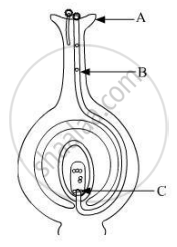Advertisements
Advertisements
प्रश्न
Type of sexual reproduction is ______.
पर्याय
Fragmentation
Regeneration
Gamete formation
Budding
उत्तर
Type of sexual reproduction is Gamete formation.
Explanation:
Sexual reproduction is always accomplished with the assistance of two germ cells. Those two germ cells are female gametes and male gametes. Meiosis is the process by which gametes are formed. The number of chromosomes is reduced to half during meiosis, resulting in the formation of haploid gametes.
Notes
Gamete formation is a process involved in sexual reproduction. It is not a type of sexual reproduction.
APPEARS IN
संबंधित प्रश्न
Name the parts A, B and C shown in the diagram and write their functions.

A student while observing an embryo of a pea seed in the laboratory listed various parts of the embryo as given below:
Testa, Tegmen, Radicle, Plumule, Micropyle, Cotyledon.
On examining the list the teacher remarked that only three parts are correct. Select three correct parts from the above list:
(a) Testa, Radicle, Cotyleddon
(b) Tegmen, Radicle, Micropyle
(c) Cotyledon, Plumule, Testa
(d) Radicle, Cotyledon, Plumule
Name and differentiate between the two modes of pollination in flowering plants.
A student identified the various parts of an embryo of a gram seed and listed them as given below :
(I) Testa
(II) Plumule
(III) Radicle
(IV) Cotyledon
(V) Tegmen
Out of these the actual parts of the embryo are :
(A) I, II, III
(B) II, III, IV
(C) III, IV, V
(D) II, IV, V
"The chromosomal number of the sexually producing parents and their offspring is the same." Justify this statement.
The fusion of male and female gametes is termed as ______.
Explain what you understand by sexual reproduction.
Name the male part of the flower.
What are the reproductive organs in a flower?
What is the name of female part of a flower?
What is the name of female organ of a flower (other than carpel)?
Fill in the following blank with suitable word :
Ovules contain ......... gametes of a plant.
Fill in the following blank with suitable word :
The ovule becomes a .......... after fertilisation.
What is pollination? How does pollination occur?
Which among the following statements are true for unisexual flowers?
(i) They possess both stamen and pistil
(ii) They possess either stamen or pistil
(iii) They exhibit cross pollination
(iv) Unisexual flower possessing only stamens cannot produce fruits
(a) (i) and (iv)
(b) (ii), (iii) and (iv)
(c) (ii) and (iii)
(d) (i), (iii) and (iv)
In a bisexual flower, inspite of the young stamens being removed artificially, the flower produces fruit. Explain.
Fill in the blank by selecting suitable word:
A flower bearing only male or female parts is known as __________ flower.
What is a flower ? Draw a neat labelled diagram showing the L.S. of a typical flower.
List any two differences between pollination and fertilisation.
What is pollination? Mention its types.
Answer the following question.
How does suitable pollination lead to fertilization?
Find the odd one out:
What does germination mean?
The essential parts of a flower are ______.
In which of the following manner the arrangement of megaspores in a tetrad is observed in angiosperms?
Which of the following is the outermost protective layer of anther?
Generally, in a pollen tube, which of the following moves to the tip of the tube?
The 3-celled egg apparatus at the micropylar end comprises of ______
Sperm and egg nuclei fuse due to ______.
Flowers showing ornithophily show few characteristic like ______.
The process of release of eggs from the ovary is called ______
Pollen grains are produced by ______
Variations occur as a result of ______
Which out of the following processes does not lead to the formation of clones.
Which among the following statements are true for unisexual flowers?
- They possess both stamen and pistil
- They possess either stamen or pistil
- They exhibit cross pollination
- Unisexual flowers possessing only stamens cannot produce fruits
Trace the path a male gamete takes to fertilise a female gamete after being released from the penis.
Sexual maturation of reproductive tissues and organs are necessary link for reproduction. Elucidate.
Explain the post fertilization changes that occur in the ovary of a flower.
